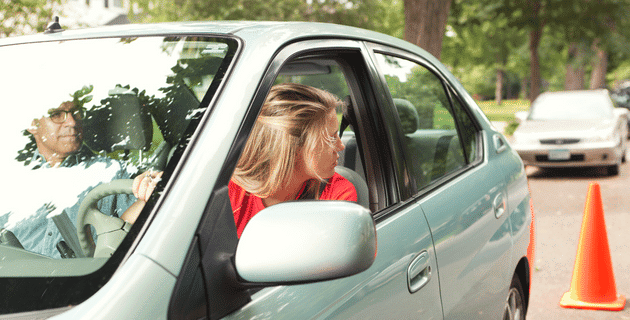Teaching your child to drive can be exciting and emotional, and you want it to go as smoothly as possible. If you’re getting ready to slip into the passenger seat alongside your teen, remember, you’ve got this. In honor of Teen Driver Safety Week, we’ve put together a guide to help.
Tip #1: Remember there is no common sense for new drivers.
Your teen is used to zoning out on car rides, maybe listening to music on headphones or playing with his/her phone. As a result, teens may not even know familiar routes. They also probably won’t understand the impact of some decisions that they make behind the wheel. Before you even get in the car, prepare your young driver for the road.
-
- Make sure your son or daughter knows the special driving rules for teens in your state, such as curfews and number of passengers allowed.
- Show your teen where the car’s registration and insurance are kept.
- Set the rules to minimize distracted driving. If you allow the radio or other music, make sure it’s set before you drive. Avoid eating while driving. Keep cell phone use for emergencies only.
- Discuss when your teen should pull over to the side of the road, such as when he or she is drowsy or when ambulances or police cars sound their sirens.
- Note that there are rules of the road to follow, and sometimes being nice (e.g. braking hard on a major road to let a car in) is an unexpected move that could cause an accident.
Tip #2: Practice in the parking lot.
Remember that basic driving skills are natural to you but new to your child. Take the time to practice in a low-pressure environment, such as an empty parking lot. Spend at least three 45-minute sessions with your teen in the lot before moving on to other driving scenarios.
-
- Practice adjusting and using side and rearview mirrors.
- Remember to look where you want to go.
- Start and stop smoothly. Experiment with stopping distances based on speed.
- Understand the vibrations of the anti-lock braking system which can startle drivers.
- Practice driving on the right side of the road and making turns into the correct lane.
- Pull into parking spots and back out.
Tip #3: Build skills slowly.
Slowly progress to roadways requiring different levels of driving skill. Spend at least 2 hours each on the following areas before moving on to the next level.
On neighborhood roads, practice:
-
- The position of your car on roads with and without lines.
- Turning right and left, with and without stop signs.
- Giving the right of way.
- Parking at the curb including parallel parking.
On easy main roads, practice:
-
- Lane changing (check mirrors, then signal, check blind spot and then change lanes).
- How far back a car is in reality based on how it looks in the mirror.
- Right of way at intersections.
- Sharing the road with other vehicles, pedestrians, and bicycles.
- Using the shared left turning lane to exit the road.
On high-speed main roads, practice:
-
- Lane changing at high speeds (different in feel from changing at low speeds; less steering required).
- Merging onto a high-speed road.
- Negotiating traffic circles and U-turns.
On highways, practice:
-
- Merging onto a highway from an entrance ramp and exiting on an exit ramp.
- Using mirrors to merge and change lanes.
- Which lane to use for which purpose (e.g. left is the passing lane).
- How to identify your location if your car breaks down on the highway.
Tip #4: Lead by example.
Your son or daughter may inherit your driving habits, so make sure to model the behavior that you want to see. As your teen becomes more comfortable driving, he or she may become critical of your driving habits. Use those as teaching opportunities.
When you drive:
-
- Enter the GPS destination before you leave.
- Wear your seatbelt.
- Don’t text and drive. Don’t eat and drive. Don’t drink and drive.
- Don’t speed.
When your teen drives:
-
- Respect your teen as an adult. Don’t micromanage the driver.
- Avoid high levels of emotion. That can create fear. Anticipate dangers and discuss them calmly before you reach them.
- Remember to praise your teen for a job well done.
Make sure that your car is well maintained and fully insured with your teen listed on the policy. Talk to your insurance agent about ways that you can save with a teen driver.
This article is furnished by California Casualty, providing auto and home insurance to educators, law enforcement officers, firefighters, and nurses. Get a quote at 1.866.704.8614 or www.calcas.com.
- Graduation – When to Remove Your Child from Your Auto Policy - May 18, 2023
- How to Prevent Catalytic Converter Theft - May 17, 2023
- How Much Does Home Insurance Cost? - May 17, 2023

